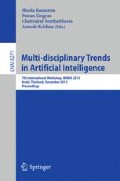Abstract
In this paper we propose and evaluate a method of Hindi word sense disambiguation that computes similarity based on the semantics. We adapt an existing measure for semantic relatedness between two lexically expressed concepts of Hindi WordNet. This measure is based on the length of paths between noun concepts in an is-a hierarchy. Instead of relying on direct overlap the algorithm uses Hindi WordNet hierarchy to learn semantics of words and exploits it in the disambiguation process. Evaluation is performed on a sense tagged dataset consisting of 20 polysemous Hindi nouns. We obtained an overall average accuracy of 60.65% using this measure.
Access this chapter
Tax calculation will be finalised at checkout
Purchases are for personal use only
Preview
Unable to display preview. Download preview PDF.
References
Hindi Corpus, http://www.cfilt.iitb.ac.in/Downloads.html
Hindi WordNet, http://www.cfilt.iitb.ac.in/wordnet/webhwn/wn.php
Budanitsky, A., Hirst, G.: Evaluating WordNet-based Measures of Lexical Semantic Relatedness. Computational Linguistics 32(1), 13–47 (2006)
Hirst, G., St-Onge, D.: Lexical chains as representations of context for the detection and correction of malapropisms. In: Fellbaum, C. (ed.) WordNet: An Electronic Lexical Database, pp. 305–332 (1998)
Jiang, J., Conrath, D.: Semantic similarity based on corpus statistics and lexical taxonomy. In: Proceedings on International Conference on Research in Computational Linguistics, Taiwan, (1997)
Khapra, M., Bhattacharyya, P., Chauhan, S., Nair, S., Sharma, A.: Domain Specific Iterative Word Sense Disambiguation in a Multilingual Set-ting. In: Proceedings of International Conference on NLP (ICON 2008), Pune, India (2008)
Leacock, C., Chodorow, M.: Combining local context and WordNet similarity for word sense identification. In: Fellbaum, C. (ed.) WordNet: An Electronic Lexical Database, pp. 265–283 (1998)
Lin, D.: Using syntactic dependency as a local context to resolve word sense ambiguity. In: Proceedings of the 35th Annual Meeting of the Association for Computational Linguistics, pp. 64–71 (1997)
Reddy, S., Inumella, A., Singh, N., Sangal, R.: Hindi Semantic Category Labeling using Semantic Relatedness Measures. In: Proceedings of Global WordNet Conference (2010)
Resnik, P.: Using information content to evaluate semantic similarity in taxonomy. In: Proceedings of the 14th International Joint Conference on Artificial Intelligence, Montreal, pp. 448–453 (1995)
Singh, S., Siddiqui, T.J.: Evaluating Effect of Context Window Size, Stemming and Stop Word Removal on Hindi Word Sense Disambiguation. In: Proceedings of the International Conference on Information Retrieval & Knowledge Management, CAMP 2012, Malaysia, pp. 1–5 (2012)
Sinha, M., Kumar, M., Pande, P., Kashyap, L., Bhattacharyya, P.: Hindi Word Sense Disambiguation. In: International Symposium on Machine Translation, Natural Language Processing and Translation Support Systems, Delhi, India (2004)
Sinha, R., Mihalcea, R.: Unsupervised Graph-based Word Sense Disambiguation Using Measures of Word Semantic Similarity. In: Proceedings of the International Conference on Semantic Computing, ICSC 2007, pp. 363–369 (2007)
Torres, S., Gelbukh, A.: Comparing Similarity Measures for Original WSD Lesk Algorithm Advances in Computer Science and Applications. Research in Computing Science 43, 155–166 (2009)
Author information
Authors and Affiliations
Editor information
Editors and Affiliations
Rights and permissions
Copyright information
© 2013 Springer-Verlag Berlin Heidelberg
About this paper
Cite this paper
Singh, S., Singh, V.K., Siddiqui, T.J. (2013). Hindi Word Sense Disambiguation Using Semantic Relatedness Measure. In: Ramanna, S., Lingras, P., Sombattheera, C., Krishna, A. (eds) Multi-disciplinary Trends in Artificial Intelligence. MIWAI 2013. Lecture Notes in Computer Science(), vol 8271. Springer, Berlin, Heidelberg. https://doi.org/10.1007/978-3-642-44949-9_23
Download citation
DOI: https://doi.org/10.1007/978-3-642-44949-9_23
Publisher Name: Springer, Berlin, Heidelberg
Print ISBN: 978-3-642-44948-2
Online ISBN: 978-3-642-44949-9
eBook Packages: Computer ScienceComputer Science (R0)

